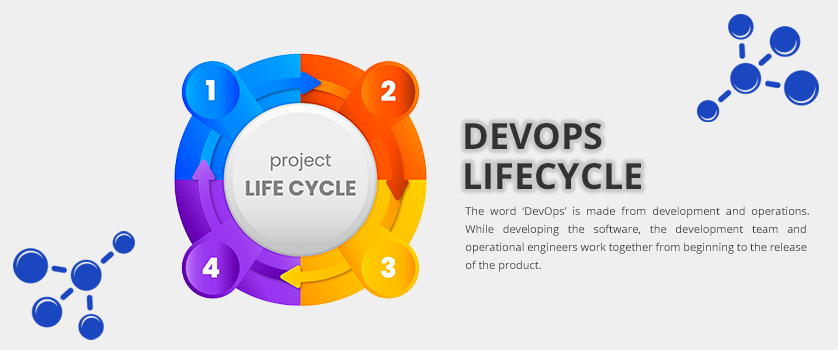
What Is the DevOps Lifecycle?
The word ‘DevOps’ is made from development and
operations. While developing the software, the development
team and operational engineers work together from beginning to
the release of the product. Since these days applications are
developed in an iterative environment, the DevOps team goes
through many iterations or cycles - known as DevOps lifecycle.
The goal of the DevOps lifecycle is to make effective and
secure applications.
Stages of DevOps Lifecycle
DevOps’s primary implementation was seen in the
development of e-commerce websites, cloud-native applications,
and other large platforms. Its multiple phases work
continuously which we know as DevOps lifecycle. Here is a list
of stages that acts as a cycle:
-
Continuous Development:
In the first phase of the DevOps lifecycle, the team
prioritizes the application’s objective in accordance
with the client’s requirement. Once the priorities are
set, the team involves project development. It, usually,
starts with the code generation and taking it to the next
step. Remember, the same approach is applicable to each
objective. Being a continuous process, the DevOps team also
works on the existing code after receiving the
feedback.
-
Continuous Integration:
This phase acts as a bridge between development and testing.
As the development phase starts, the integration process
starts automatically. The continuous integration process
includes planning for the test in the next stage, checking
product outcomes based on initial project
documentation.
-
Continuous Testing:
The application is put to test in the real environment. It
is not the deployment phase instead it is known as beta
testing. The purpose of beta testing is to find out how the
application performs in the real environment. If it shows
the intended or unexpected outcome. Based on the results
observed in this stage, the team decides whether it will be
sent for improvement or not.
-
Continuous Monitoring:
It’s the operational phase of the DevOps lifecycle
where the data of the application’s usage is recorded
and processed to identifies the trends and problem areas.
The purpose of monitoring the application while keeping it
in continuous use is to enhance the operational efficiency
of the application.
-
Continuous Feedback:
Based on the application’s final outcome, the
performance is improved. Another way of improving the
app’s performance is customer feedback. It’s a
continuous process and it plays a crucial role in enhancing
the current product. Plus, it helps teams to release new and
improved versions of the software.
-
Continuous Deployment:
This phase involves the deployment of the final code to the
production servers. The key challenge of this phase is to
maintain consistency with the precise deployment of the code
on all servers. Hence, Configuration Management comes into
the picture that handles code deployment, updates
scheduling, and consistency throughout the production
process.
-
Continuous Operations:
The goal of this phase is to automate the process of release
and subsequent updates. Unlike other phases, this one is the
shortest and easiest phase as development cycles in
continuous operations are shorter that allows developers to
accelerate the time to market for the application.
Benefits of DevOps Lifecycle
-
Better Customer Experience:
Customers need quick assistance from the service provider
and the DevOps lifecycle ensures it. Be it providing
timely updates or making changes in the product, each
DevOps lifecycle phase magnifies user experience.
-
Seamless Digital Transformation: DevOps ensures that any industry can transform itself
using technology. Apart from the transformation,
industries can scale with maximum speed and
accuracy.
-
Ensures Consistent Communication:
The DevOps lifecycle breaks many barriers that result in
confusion and delays. The entire lifecycle is designed in
such a way that it improves the collaboration among the
team members, and all the teams work together to develop a
stable product in less time.
-
Faster Defect Detection:
DevOps lifecycle is a continuous process that helps teams
to detect the problems faster. Be it preliminary testing
or customer feedback (suggestions for improvement),
chances are that defects are not only found early but
resolved quickly too.
Conclusion
DevOps lifecycle is an innovative way of developing any
application. It improves the application’s performance
because it goes through an iterative process that allows users
to share their valuable feedback from the development phase.
No doubt it will replace all the application development
processes in the future because it provides agility,
scalability, and affordability.


